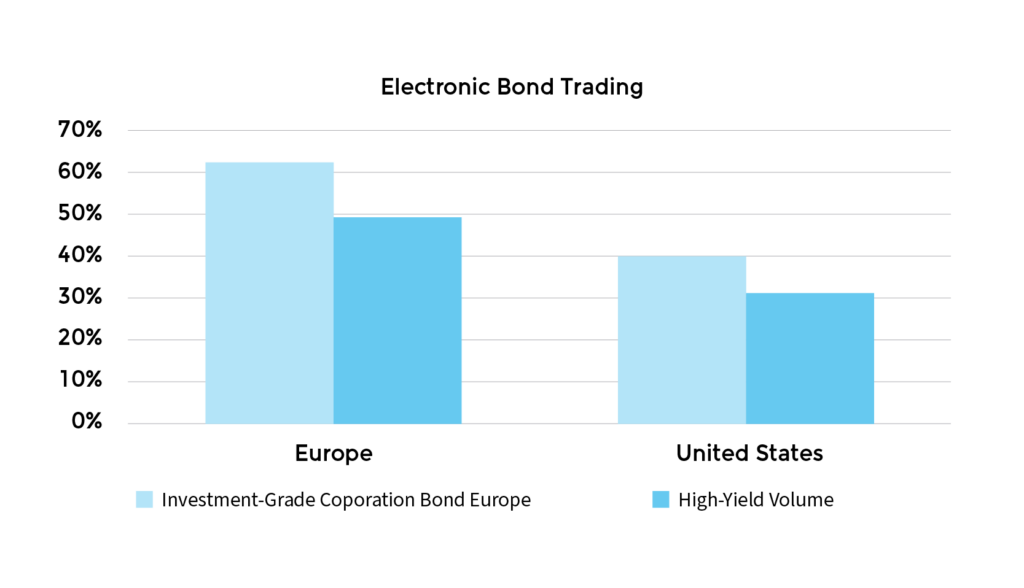The pressing case for workflow automation in fixed income
Workflow automation is not a new theme in the fixed income world, but the noise has grown louder with the rapid development of electronic trading and the advancement of technology.
Firms can no longer afford to turn a blind eye to cumbersome manual processes. It is imperative they improve efficiency, enhance performance, and better mitigate risk as seismic forces alter market parameters. The shift to a shorter settlement period (T+1), competition from new entrants, the rise of new trading models such as portfolio trading, and growing liquidity fragmentation are a few of the challenges market participants face.
As the last few years have shown, the road to mechanization is far from smooth, which explains why the subject continues to feature prominently at conferences, seminars, and podcasts.
This year will be no different with a recent paper by Coalition Greenwich – Top Market Structure Trends to Watch in 2024 – identifying workflow automation as one of the hottest topics.
Workflow digitalization not yet widespread
This is because manual inputs, phone calls, emails, and spreadsheets are still commonly used, according to a separate report by Celent – The Future of Fixed Income Tech: The Allure of Small Steps.
Although the most liquid markets in government bonds, interest rate swaps, and some credit and credit derivatives trade electronically, full trading workflow digitalization is not yet widespread.
This can be attributed to several factors including resistance to change, lack of industry-wide standards, information, and transparency, as well as complex and outdated in-house-built tech stacks.
Fixed income has also been particularly impacted by its fragmented ecosystem. Unlike its more electronically driven FX and equities counterparts, fixed income has a much larger array of instruments. This has led to a patchwork of trading protocols, pools of liquidity, pricing structures, reporting regimes, data, and workflows that are distinctive to each market.
The extent of electronic trading varies according to the region and the instrument.
A report from Coalition Greenwich found that 62% of European investment-grade corporate bond trading volume was executed electronically in 2022 – making Europe the most electronic bond market globally. Some 49% of notional high-yield volume was also executed electronically. The figure was higher than in the US which saw 40% of investment-grade and 31% of high-yield volume going through the pipes.
Breaking down the barriers
Against this backdrop, the crowded desktop crammed with multiple, incompatible applications, including several market User Interfaces (UIs), precious time is wasted opening multiple applications and breaking down siloed workflows. It is now not only labor intensive and time consuming but eats further into the bottom line.
Without the requisite tools and data, traders cannot make the right decisions to circumvent the threats but also leverage the opportunities that volatility can generate.
Given the diverse nature of fixed income and its participants, a one-size-fits-all solution is often not possible, but firms can take several common developmental steps.
The most significant is interoperability or breaking down the barriers between the myriad of disjointed systems and processes that have been built through the years.
Solutions are at hand
Every element of the tech stack should be able to communicate with each other more effectively. To reach this goal, firms should consider transitioning some parts of their workflow to integrated solutions that can:
- Collect market data from various, heterogeneous sources, including past trading activity;
- Allow rich negotiation functionality and integration with internally developed proprietary algo tools;
- Aggregate trading activity from various platforms to maximise access to liquidity;
- Ensure all information is available for automated decision-making, such as inventory, risk exposure, relative value and client activity; and
- Integrate the information with rich and flexible UIs to allow traders to maintain oversight, such as in high-touch trading activity, which may need trader intervention.
Market participants need technology that can bolster trading capabilities as market structure evolves.
This is especially true in trade execution, and as we wrote late last year, buy- and sell-side firms do not have to look far for solutions. Newer, more sophisticated versions of execution management systems (EMS) software can digitize the entire dealer-to-customer (D2C) trading process.
An EMS can help achieve best execution across different bond asset classes, ensuring optimal pricing for the buy-side among various D2C markets and retail venues, but also providing buy-side capabilities to sell-side traders through direct execution, along with pre-trade and post-trade hedging. Moreover, it fulfils regulatory requirements by providing an audit trail of all execution steps.
APIs generally should be front and center of a modern, customised trading desks, as they facilitate interoperability, break down silos and are a gateway to further innovation. They also have the advantage of scalability and plug-in solutions based on them can be up and running in weeks.
Combined with the power of cloud technology to synthesize masses of data, which is of critical importance to making well-informed trade decisions, they provide trading desks with a competitive edge.
Benefits of a holistic approach
There are many advantages to creating a more rounded environment in fixed income. Most notably, traders can access high quality market data, risk analytics and trading tools seamlessly across different source and providers.
They can also share information more easily with portfolio managers and research analysts in real time, allowing them to better meet their investment and client objectives. Equally as important, different stages of the order-to-trade life cycle are connected, from idea generation, liquidity picture, and post-trade analytics.
However, interoperability is not just about fixing the current problems though. It is a foundation that sets the tone for future technology investment and places capital market participants in a position to leverage further developments in other technologies, including artificial intelligence. Trading and investing in bonds have become more complicated, and firms need a holistic plan that keeps their competitive edge sharpened and enhances profitability.
Don't miss out
Subscribe to our blog to stay up to date on industry trends and technology innovations.



